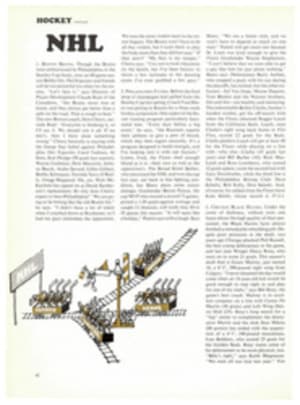
SCORECARD
ESCAPADES ON CAMPUS ICE
What began as a seeming death knell for college ice hockey in the U.S. may end as nothing more than an old-fashioned power play. It was reported last week that the National Collegiate Athletic Association's council, meeting next Monday in Hollywood, Fla., would consider dropping the sport. Not entirely true. The subject will come up, but in the broader relationship of professional to college athletics. The expectation is the council will compromise if it can assure itself of a firmer voice in amateur hockey.
The NCAA's difficulties with hockey revolve around differences with the Canadians, who provide a majority of the top performers on U.S. college teams. Tier One players in the Junior A leagues, Canada's best for youths ranging from early to late teens, are paid $60 a week, making them professionals in NCAA eyes, but from the Canadian standpoint no more professional than U.S. college athletes who eat at training tables and sleep in special dormitories. Tier One players pay for their room and board and receive no laundry allowance.
Particularly galling to the NCAA is a grant of $57,775 made by the National Hockey League to the Midwest Junior Hockey League based in Minneapolis. Major league baseball similarly supports U.S. college circuits, but these, says the NCAA, are certified and supervised by it. The players receive only expense money. They may earn more during off-baseball hours by taking local jobs at the going rate.
Obviously the NCAA would be happy to supervise the Midwest League and work out a modus operandi with the Canadians. But even if a compromise cannot be struck, the free ride through U.S. colleges for Canadian hockey players is far from doomed. In the unlikely event that the NCAA dropped hockey, most if not all of the 87 member schools that play the game (105 others have club teams) would continue to do so. Many have heavy investments and long traditions and, apparently, all have nothing to fear from the NCAA, which will not subject them to penalties in other sports. Such action might serve only to give the colleges ideas of independence. So expect a horse trade.
MINIATURIZATION
What with the high cost of living and scarcity of feed grain, even Texas is thinking small these days. The Neiman-Marcus annual Christmas catalog is out, and this year's gift for the consumer who has everything is a 12-foot-square mouse ranch, for goodness sakes. It comes complete with mesa, cactus, corrals, feed bins and silver-plated "roundup tweezers," but even the seductive words of President Stanley Marcus—"Imagine the thrill of sitting around the campfire (or fireplace) singing songs of the prairie under the full moon (or lamp) with your own herd lowing softly (or squeaking gently)"—are not going to hide the fact that it costs $3,500.
Japan, where the people naturally start from a smaller base than in Texas, has fallen on equally hard times. With the cost of dog food at $1.70 a pound, Tokyo department stores are featuring insects as pets. The price varies from 50¢ to $3 a bug depending upon size, sex and supply. Females are cheaper, not necessarily because this is the East. One store reported sales of $10,000 in one month, not including revenues from insect cages, insect exercise wheels, breeding kits, bug nets and books on insect care. Another created a screened-in rooftop insect park. Trees and grass were planted, millions of grasshoppers and beetles and other crawly things were imported, and children were provided with nets and allowed to roam the meadows snaring critters to their hearts' delight—for which Mama-san paid dearly downstairs.
If the trend holds, it won't be long before we're all thinking up funny names for our friendly pet amoebas.
PEANUTS GOES TO COLLEGE—AAUGH!
Washington & Lee University, loser of 10 straight games, was leading Randolph-Macon 20-18 with one second to go when a W&L freshman defensive back intercepted a pass on his own five-yard line. Salted the game away, right? No. The young man skipped into his own end zone and touched the football down—for a safety and a 20-20 tie. His name, sorry to report, is Charley Brown.
AAUGH! AAUGH!
Brigham Young was leading Colorado State 33-27 with just six seconds remaining. BYU Quarterback Gary Sheide was going to run out the clock by falling on the ball, but an unearthly yell by CSU Linebacker Kevin McLain rattled his concentration, and suddenly the ball was resting under a CSU man on the BYU 15-yard line with three seconds to go. CSU scored on a down-and-outer to Willie Miller to tie the score at 33 after time had run out. Then came the confusion.
The Ram bench erupted onto the field to bury Miller in a joyous heap. Not proper, says a conference rule: interfering "with orderly game administration." Fifteen-yard penalty. Ordinarily, the penalty would be levied in the placement of the ball for the ensuing kickoff, but since the game was over it was tacked on to the yardage for the extra-point try, making that about a 35-yard effort.
The ball was up, 'ray! But it was too far to the left and the official was signaling no goal. Aaugh! Wait. The official's hands were in the air, the signal for a good kick. Again, 'ray! Up went 34-33 on the scoreboard, where it stayed for 30 minutes, and away went the home crowd laughing.
Then the dreadful truth emerged. Official Jack Moyers, finally making himself heard over the din, said the kick was no good. League rules call for him to take the football in his hands and hold it high above his head to signal the end of the game. Since he couldn't find a ball, he just held up his hands. Good thinking, Moyers, and aaugh! Again.
EAST, MEET EAST
The People's Republic of China is exacting a high price for its sudden emergence as a world power in sports. The Red Chinese will be good playmates only if Taiwan is excluded, and their latest victim is the Taiwanese volleyball team. As the Nationalist China players sat in neighboring Guatemala awaiting visas to Mexico, where the eighth world championships began last weekend, the International Volleyball Federation voted 54-18 to bar them from the competition.
The vote to exclude was as unfair as the action taken during the post-World War II era, when Communist China was told it could enter the Olympics only under the banner of Nationalist China, which it refused to do. After years of competing under the same flag, East and West Germany are recognized as separate entities in international contests, as they are now in the United Nations. The UN banished the Nationalists when it accepted Red China as a member, but that is no reason for sports federations to follow suit. They recognized German and Japanese athletes long before the UN admitted those countries. Athletics should be for everyone, for the two Germanies, for the two Chinas. Sport's ground rules are nonpolitical.
FOREMAN'S GOT RHYTHM
As cautious as George Foreman was in setting a new date for his bout with Muhammad Ali, he may have made it too late. According to a computer printout graph of his biorhythm cycles—there are three: physical, emotional and intellectual—the perfect day for the fight would have been this Sunday and not Oct. 29. Oct. 20 is the day all three of his cycles converge at the top of the "up" curve, something that occurs rarely, according to United Computing Systems, Inc. of St. Louis, which pulled the graph.
The biorhythm theory originated before the turn of the century in—where else?—Vienna. Believers hold that from the day of birth human lives move in predictable undulations involving the three separate cycles. People go from plus to minus on a curve and it is when they are on their downs that they should stay in bed and pull the covers over their heads. Foreman's three cycles will be downers on Oct. 29 but, according to another UCS, Inc. graph, the same is true of Ali's, only more so. The prognostication is for a mauling fight, with Foreman achieving an edge, unless the challenger finds a way to throw a new curve into those bio-rhythmic graphs.
MENACE IN THE IVAN
For a brief second there, an international incident seemed to be brewing. After checking into Moscow's Hotel Rossiya, Team Canada member Pat Stapleton complained to Manager Bill Hunter: "My room is bugged."
Hunter, horrified: "How do you know?"
Stapleton: "I can see them running around the bathroom."
CAGEY RUN AT A RECORD
"Really, it's the most boring thing I've ever done." The speaker was Neal Watson, and he was describing his training for the latest—and one of the hairiest—assaults on a category in the Guinness Book of World Records. Already holder of the world depth record for scuba at 437 feet (he claims six people have died trying to break it), the 34-year-old Watson is planning a 150-mile underwater swim from Islamorada in the Florida Keys to West Palm Beach, where he owns a nightclub. He will follow the Gulf Stream about 10 miles offshore.
To get ready for his ordeal, Watson strung a half-mile long rope in 30 feet of water off the Bahamas and swam back and forth for six to eight hours a day until bad weather drove him to his pool, where he resumed the daily marathons. "I've been training for six months," he said last week. "Mostly it's conditioning your legs and your mouth to hold the mouthpiece, getting used to the mask, strengthening the tendons and muscles behind the ankles. You run out of things to think about down there and your mind can wander. You have to learn mind control."
One thing Watson thinks about a lot is the peril of sharks. "I'll have to swim one complete night and perhaps part of another. The Gulf Stream is probably the most shark-infested area in the world. That's where the shipping lanes are; the water is warm and the ships throw out their garbage in that area. The sound of boats attracts sharks; they're also attracted to light and I'll be swimming with lights at night."
The expedition, which is being directed by former Astronaut Scott Carpenter, will get under way Nov. 15, weather permitting. It has been postponed twice. Watson calculates it will cost about $50,000 and hopes to make that back with a movie or TV special and product endorsements. There will be a 65-foot charter boat trailed by a support boat pulling a 6-foot-by-7-foot shark cage.
Watson will be swimming behind the cage. The present underwater record, he says, is 48 miles, set in the English Channel in 1962. "Two years ago a guy tried to swim the Gulf on the surface in a cage," says Watson. "He aborted when the sharks began nibbling his cage."
Watson will be swimming about 40 to 50 hours and expects "my skin will begin to deteriorate." He will eat a liquid high-protein nutriment but has been practicing with candy bars underwater—"Not very appetizing"—and will be watched by an underwater closed-circuit television system. "If the sharks get too bad," he says, "I'll swim into the cage and proceed in it, if I can make the cage in time."
Better that than nutriment for the sharks.
ILLUSTRATION
THEY SAID IT
•John Keith, Oklahoma publicist, on 6'6", 290-pound tackle Mike Vaughan: "He plays right offensive mountain."
•Bill Walton, asked what is his biggest adjustment since entering pro basketball: "Deciding what to do with my free time."
•Robert Harris, Canadian millionaire, describing what he would do if his Portland Storm, last in the WFL Western Division, lost a million dollars this season: "I'd sell one of my buildings and I'd only have 49 left."
•Jim Sweeney, Washington State coach, whose team lost to Ohio State 42-7, on the advisability of playing the Buckeyes: "There's no good place to have Ohio State on your schedule—except New Year's Day."

